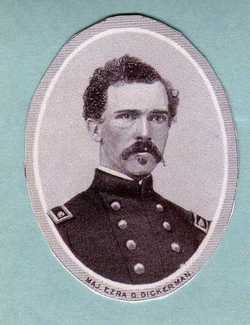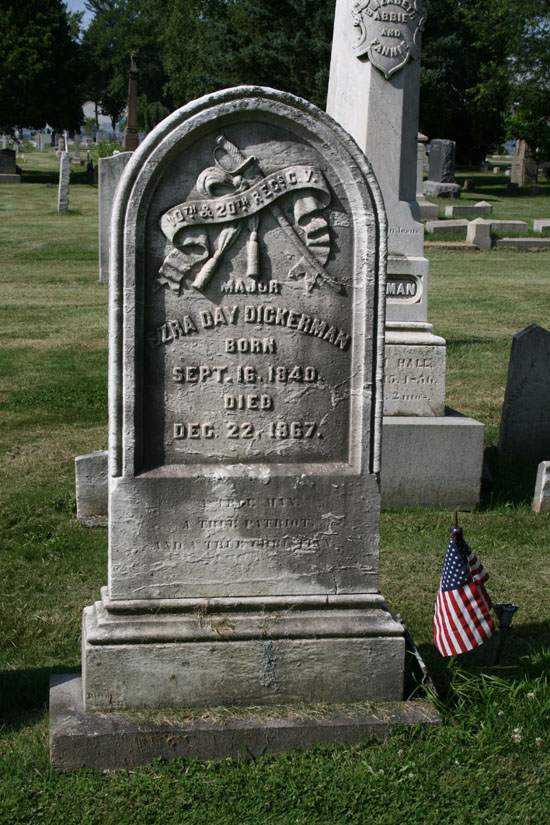Married Mary Louise Lacey in 1864
Born in 1840 to Ezra and Sarah Dickerman, Ezra was a schoolteacher prior to the war and cousin to Caroline. A pacifist, he mentioned moving to Canada in the advent of a civil war, but his father told him “a man never gains anything by shirking his duty to his country”. Soon after, his father died. A year later, when the Civil War began, Ezra decided to enlist into Company A, 10th Connecticut Volunteers, as a corporal. He was shot through the chin at the battle of Roanoke Island and as soon as his wound was dressed he went back to the ranks.
In 1862, men from his hometown began organizing Company I of the 20th Connecticut, and Ezra was chosen to be the second lieutenant. Henceforth, he returned home to prepare his men for the field – but before reaching home he was promoted to captain of the new company. Ezra was wounded severely at Chancellorsville by being struck by a musket-ball in his hip, and returned home on a leave of absence to recover. However, shortly thereafter he heard that a great battle was imminent and immediately proceeded to rejoin his regiment for the battle of Gettysburg.
The regimental history authored by John Storrs mentions his trip back to his regiment:
Though still limping from his wound, instead of asking for a renewal of the furlough, he started in all haste for the scene of impending conflict, the exact location of which he could not ascertain. Taking a pork train moving southward, which he concluded would not go far out of the way, he mounted a barrel and rode all night to Westminster, where, learning the direction of the battle-ground, he started, crippled as he was, on foot, and covered the distance (35 miles) in time to present himself for duty about five minutes before the battle began. When asked why he was so anxious to “go in” he replied, “I promised the boys to stand by them, and knew they would want me with them.”
At the battle of Peach Tree Creek in 1864, he received his third wound of the war. A bullet struck him in the head, and he was left for dead by a surgeon. If it had not been for his cousin, Ezra would have almost certainly died on the battlefield as he was wounded too badly to be moved. Mark Dickerman received a pass and cared for Ezra on the field until he was well enough to be relocated to a hospital in Nashville, where the bullet was removed and he began to recuperate. Once he was well enough, he was assigned to duty in the conscript camp of New Haven, Connecticut and served as the head of the commissary department. During this time he married Mary Louise Lacey and was promoted to Major.
In May of 1865, one month before the end of the war, Ezra rejoined his regiment, and was mustered out of service with the rest of the regiment on June 13th.
Ezra and Mary’s first child was born to them just a few months later on December 5th, 1865. Almost two years later, they had another son, who was given the same name as his father: Ezra Day Dickerman.
During this time, Ezra began experiencing very painful headaches as a result of the head wound he received at Peach Tree Creek in 1864.
On December 22nd, 1867, just one month after the birth of his namesake, Ezra Dickerman died from the effects of the head wound he received at Peach Tree Creek. At the young age of 27 years, sincerely mourned by his veteran comrades and by all who knew him, he was taken from this life. On the day of his burial, his pastor said of him: “A true man, a true patriot, and a true Christian”.
- http://cecilsletters.com/history/people/soldiers/ezra-dickerman
- “Families of Dickerman Ancestry”, page 461
thank you,
Russ Gunther
-------------------------
Married Mary Louise Lacey in 1864
Born in 1840 to Ezra and Sarah Dickerman, Ezra was a schoolteacher prior to the war and cousin to Caroline. A pacifist, he mentioned moving to Canada in the advent of a civil war, but his father told him “a man never gains anything by shirking his duty to his country”. Soon after, his father died. A year later, when the Civil War began, Ezra decided to enlist into Company A, 10th Connecticut Volunteers, as a corporal. He was shot through the chin at the battle of Roanoke Island and as soon as his wound was dressed he went back to the ranks.
In 1862, men from his hometown began organizing Company I of the 20th Connecticut, and Ezra was chosen to be the second lieutenant. Henceforth, he returned home to prepare his men for the field – but before reaching home he was promoted to captain of the new company. Ezra was wounded severely at Chancellorsville by being struck by a musket-ball in his hip, and returned home on a leave of absence to recover. However, shortly thereafter he heard that a great battle was imminent and immediately proceeded to rejoin his regiment for the battle of Gettysburg.
The regimental history authored by John Storrs mentions his trip back to his regiment:
Though still limping from his wound, instead of asking for a renewal of the furlough, he started in all haste for the scene of impending conflict, the exact location of which he could not ascertain. Taking a pork train moving southward, which he concluded would not go far out of the way, he mounted a barrel and rode all night to Westminster, where, learning the direction of the battle-ground, he started, crippled as he was, on foot, and covered the distance (35 miles) in time to present himself for duty about five minutes before the battle began. When asked why he was so anxious to “go in” he replied, “I promised the boys to stand by them, and knew they would want me with them.”
At the battle of Peach Tree Creek in 1864, he received his third wound of the war. A bullet struck him in the head, and he was left for dead by a surgeon. If it had not been for his cousin, Ezra would have almost certainly died on the battlefield as he was wounded too badly to be moved. Mark Dickerman received a pass and cared for Ezra on the field until he was well enough to be relocated to a hospital in Nashville, where the bullet was removed and he began to recuperate. Once he was well enough, he was assigned to duty in the conscript camp of New Haven, Connecticut and served as the head of the commissary department. During this time he married Mary Louise Lacey and was promoted to Major.
In May of 1865, one month before the end of the war, Ezra rejoined his regiment, and was mustered out of service with the rest of the regiment on June 13th.
Ezra and Mary’s first child was born to them just a few months later on December 5th, 1865. Almost two years later, they had another son, who was given the same name as his father: Ezra Day Dickerman.
During this time, Ezra began experiencing very painful headaches as a result of the head wound he received at Peach Tree Creek in 1864.
On December 22nd, 1867, just one month after the birth of his namesake, Ezra Dickerman died from the effects of the head wound he received at Peach Tree Creek. At the young age of 27 years, sincerely mourned by his veteran comrades and by all who knew him, he was taken from this life. On the day of his burial, his pastor said of him: “A true man, a true patriot, and a true Christian”.
- http://cecilsletters.com/history/people/soldiers/ezra-dickerman
- “Families of Dickerman Ancestry”, page 461
thank you,
Russ Gunther
-------------------------
Inscription
10th & 20th Regts., Civil War
Family Members
Advertisement
Explore more
Sponsored by Ancestry
Advertisement
















